|
|
|
|
|
|||||||
|
|
Budget 2001 - Budget Plan
- Table of Contents - Previous - Next -
Chapter 2
Global Economic Slowdown and Implications for Canada
Highlights
- Economic growth in all major economies slowed sharply in the first half of this year.
- A variety of factors contributed to the global slowdown, including higher interest rates and energy prices and a sharp decline in global high technology investment.
- The events of September 11 introduced a further shock to the global economy through disruptions in economic activity and sharp declines in confidence, particularly in the United States.
- Forecasters have further downgraded their outlook for the U.S. economy, incorporating a recession now underway. Weakness in the U.S. economy is expected through the first half of 2002, followed by a rebound in the second half of the year.
- This is affecting the Canadian economy, which has slowed considerably in response to weaker export demand from our largest trading partner.
- The Canadian economy contracted in the third quarter, and most private sector forecasters expect further weakness in the fourth quarter. They expect positive but modest growth in the first half of 2002, with growth picking up in the second half of the year.
- There is considerable uncertainty to the global outlook. If U.S. consumer and business confidence erode further, global growth could remain weak and the recovery could be delayed.
- Canada is better positioned than in the previous downturn of the early 1990s to weather difficult economic times because of:
- healthier finances through balanced budgets and debt repayment;
- the $100-billion tax cut, proportionately larger than in the U.S.;
- low and stable inflation;
- declining foreign debt; and
- historically low interest rates.
Note: This chapter incorporates data available up to December 3, 2001.
The world economic outlook has weakened significantly
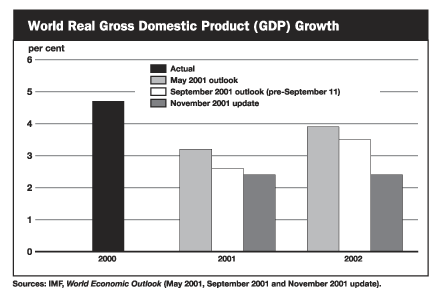
- Last spring the International Monetary Fund (IMF) expected global economic growth to average 3.2 per cent in 2001 and 3.9 per cent in 2002. However, the global economic outlook has weakened significantly since then.
- World economic conditions had begun to deteriorate before the terrorist attacks on the U.S. By early September the IMF expected global economic growth of 2.6 per cent in 2001 and 3.5 per cent in 2002 – a downward revision of about 0.5 per cent for both years.
- The events of September 11 disrupted economic activity and affected confidence in all major economies, leading the IMF to further revise down its growth forecast, particularly for 2002. The IMF now expects the return to more robust growth to be delayed until mid-2002, leaving its forecast for world economic growth at just 2.4 per cent for both 2001 and 2002.
- Although average growth is forecast to be the same in 2002 as in 2001, growth is expected to accelerate from a slow pace in early 2002 to a more robust pace by the second half of the year.
Growth was already slowing in all major economies prior to September 11, particularly in the U.S.
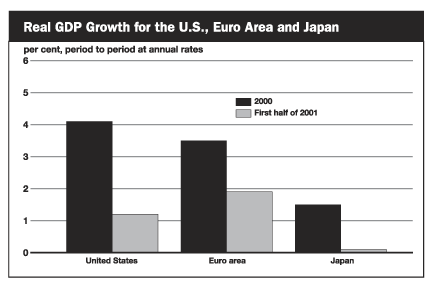
- Even prior to the September 11 terrorist attacks on the U.S., all major economies were experiencing a slowdown in growth. This synchronized slowdown was fuelled by a number of factors, including:
- monetary tightening during 1999 and 2000;
- high energy prices in 2000; and
- a sharp downturn in business investment in information and communications technology (ICT) goods accompanied by a steep decline in technology-sector equity prices.
- By the late 1990s both the U.S. and the euro area were experiencing growth that was widely viewed as unsustainably strong, fuelling fears of a resurgence of inflation. In response, monetary authorities began to increase interest rates in an attempt to engineer a soft landing for these economies.
- Rapid growth in the major economies in the late 1990s also created strong global demand for energy, which outpaced supply. In response, energy prices rose sharply and remained at high levels for longer than expected.
- The monetary tightening and high energy prices weakened global demand conditions. The slowdown was exacerbated by the sharp downturn in business investment in ICT goods. Indeed, the impact of the sharp decline in ICT investment was felt especially strongly in the U.S. – not surprisingly, as the U.S. is the world’s largest producer and user of ICT goods.
- In the first half of 2001 real U.S. business demand for ICT goods fell by 16 per cent (annual rate) – a sharp deterioration from average growth of over 20 per cent in 2000. This turnaround was responsible for over three-quarters of the overall slowdown in U.S. GDP growth from 2000 to the first half of 2001.
The terrorist attacks disrupted an already weakening U.S. economy...
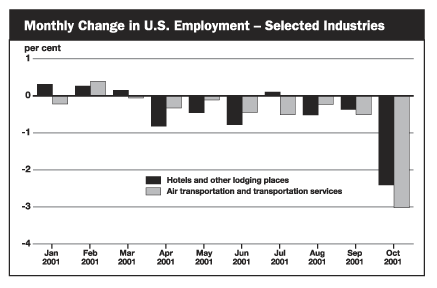
- Although the economic slowdown has been global, it has been particularly pronounced in the U.S. In this context, September 11 represented a significant shock to already weakening U.S. economic conditions.
- The impacts of the disruptions caused by the terrorist attacks appear to have been significant and widespread, affecting manufacturing output and shipments, international trade and consumer spending.
- The immediate impacts of the attacks were most evident in declines in employment. In October, in the first monthly survey after the attacks, U.S. non-farm employment fell by 415,000, its sharpest monthly drop since May 1980, with close to one-quarter of these job losses in the accommodation and air transportation industries.
...and further weakened U.S. consumer and business confidence
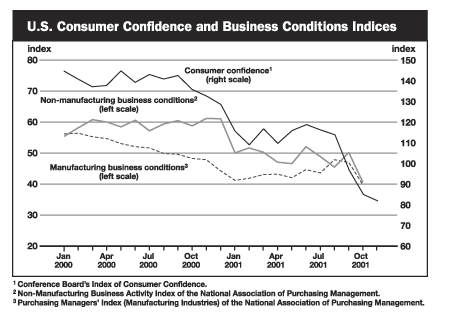
- The immediate disruptions in specific sectors of activity were accompanied by sharp declines in both business and consumer confidence.
- U.S. consumer confidence declined 14.9 per cent in September and a further 12.1 per cent in October – its largest decline over any two-month period since the invasion of Iraq in early 1991.
- The decline in confidence was reflected in the decline in consumer spending in September, the steepest monthly decline in nearly 15 years. While consumer spending rebounded sharply in October, this largely reflected unusually attractive car dealer sales incentives. Falling confidence still suggests potential weakness in consumer spending looking ahead, although there is considerable uncertainty about the outlook.
- Business confidence also fell sharply in the wake of the terrorist attacks. For example, the National Association of Purchasing Management indices for both manufacturing and non-manufacturing business activity declined sharply in October. These indices reveal widespread declines in both current and expected economic activity.
U.S. private sector forecasters expect a recovery beginning by mid-2002
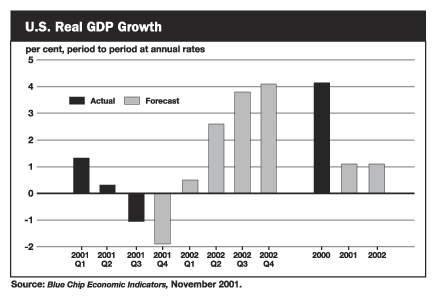
- Interruptions in economic activity in September compounded the existing slowdown, pushing real GDP growth down to -1.1 per cent in the third quarter.
- And with the deterioration in both consumer and business confidence, private sector forecasters now expect that the U.S. economy will contract further in the fourth quarter of 2001 (-1.9 per cent), leaving real GDP in the fourth quarter 0.3 per cent below its level at the end of 2000.
- On average, forecasters anticipate that the U.S. economy will return to positive although modest growth in the first half of 2002. Growth is expected to accelerate to the 4-per-cent range in the second half of the year, fuelled by:
- the lagged effects of this year’s interest rate cuts;
- U.S. fiscal stimulus enacted both before and after September 11; and
- the benefits to consumers and businesses of the recent sharp decline in energy prices.
- Given the uncertainty in the aftermath of the events of September 11, the major risk to the forecast is the possibility that consumer and business confidence will recover more slowly than anticipated.
The weak first half of 2002 is expected to constrain U.S. growth to 1.1 per cent next year
Table 2.1
U.S. Forecast Summary
|
|
||
|---|---|---|
|
2001 |
2002 |
|
|
|
||
|
(per cent) |
||
|
Real GDP growth |
||
|
October 2000 Economic Statement and Budget Update |
3.5 |
n/a |
|
May 2001 Economic Update |
1.8 |
3.2 |
|
December 2001 budget |
1.1 |
1.1 |
|
October 2000 Economic Statement and Budget Update |
2.7 |
n/a |
|
May 2001 Economic Update |
2.9 |
2.4 |
|
December 2001 budget |
2.9 |
2.0 |
|
3-month Treasury bill rate |
||
|
October 2000 Economic Statement and Budget Update |
6.2 |
n/a |
|
May 2001 Economic Update |
4.3 |
4.5 |
|
December 2001 budget |
3.4 |
2.3 |
|
10-year government bond yield |
||
|
October 2000 Economic Statement and Budget Update |
6.1 |
n/a |
|
May 2001 Economic Update |
5.0 |
5.3 |
|
December 2001 budget |
4.9 |
4.6 |
|
|
||
| Sources: September 2000, April 2001 and November 2001 Blue Chip Economic Indicators. | ||
- Private sector forecasters now expect U.S. real GDP growth to be 1.1 per cent in both 2001 and 2002. As is the case with the global outlook, however, the relatively slow pace of average growth in 2002 expected for the U.S. economy reflects the expectation of weak growth in the first half of the year combined with a return to robust growth in the second half of 2002.
- These forecasts are substantially lower than those earlier this year and at the time of the October 2000 Economic Statement and Budget Update.
- In line with lower growth expectations and energy prices, U.S. inflation is expected to decline to 2 per cent in 2002 from nearly 3 per cent this year.
- Reflecting the weaker forecasts for U.S. growth and the actions taken by the Federal Reserve Board since the beginning of the year, forecasters have sharply lowered their expectations for interest rates for next year.
Weakness in the U.S. economy has significantly affected Canadian export

- Given our close trade ties, the downturn in the U.S. economy has had a negative impact on the Canadian economy.
- Real export growth had been a substantial contributor to overall GDP growth in Canada through 1998, 1999 and the early part of 2000. However, it slowed sharply in mid-2000, before posting three consecutive steep quarterly declines starting in the first quarter of 2001. By the third quarter of this year real exports had declined 4.4 per cent from their level at the end of last year, which has contributed significantly to the growth slowdown in 2001.
- In contrast, final domestic Canadian demand continued to grow over the period, albeit at a slower pace than in much of 2000.
- By the third quarter of 2001 real final domestic demand growth had eased to 1.1 per cent, in large part due to a sharp decline in consumer spending on goods which occurred immediately following the terrorist attacks of September 11.
Labour market conditions have weakened in Canada, particularly in export-oriented manufacturing industries
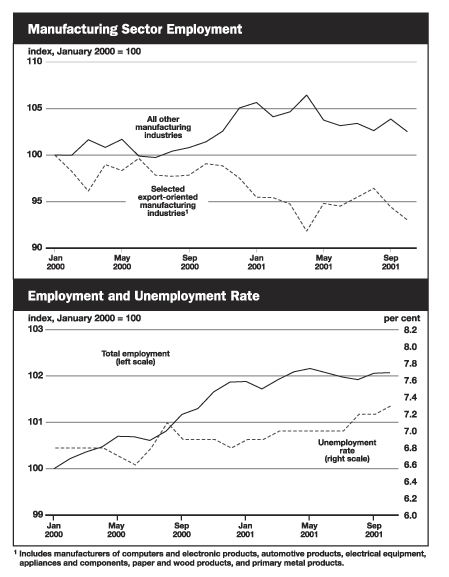
- In tandem with weakening export demand from a slowing U.S. economy, signs of weakness began to appear in labour markets in Canada early this year – particularly in export-oriented manufacturing industries. Total employment has remained virtually unchanged and the unemployment rate has risen modestly this year.
- In the aftermath of the September 11 terrorist attacks, the unemployment rate rose and employment in manufacturing industries declined. At the same time, average hours worked per employee declined sharply, indicating the possibility of further declines in employment in the months ahead.
September 11 disruptions impacted on Canadian output
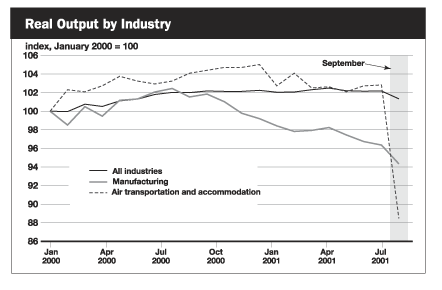
- The immediate disruptions in economic activity were also apparent in industry output, which declined by 0.8 per cent in September – its sharpest monthly decline in fifteen years.
- As in the United States, air travel and accommodation and related service industries were significantly affected in Canada in September, falling 19.1 per cent and 10.9 per cent, respectively. Significant declines were also reported in retail trade industries, which faced a sharp decline in consumer spending in the days following the terrorist attacks. As well, production of motor vehicles and parts dropped sharply in the month, in part reflecting delays at the Canada/U.S. border and supply shortages.
- While these industries account for just over 8 per cent of aggregate output in the economy, they contributed close to one-half of the overall decline in September.
- The overall Canadian manufacturing sector, which had already slowed significantly in response to the existing slowdown in the U.S., fell a further 2.1 per cent as a result of the September 11 disruption.
A smoothly functioning Canada-U.S. border has become increasingly important to the Canadian economy

- A well-functioning Canada-U.S. border is critical to the Canadian economy, and to the manufacturing sector in particular. In fact, two-way merchandise trade between the two economies rose from about $100 billion in 1980 to over $600 billion in 2000, while its share of Canadian GDP almost doubled to close to 60 per cent during the same period. Including trade in services, two-way trade between Canada and the U.S. now totals close to $2 billion per day – by far the largest two-way trade between any two countries.
- A smooth flow of goods across the border is also important for the U.S. economy as Canada is the largest export market for the U.S., receiving about 25 per cent of its exports.
- Since September 11 concern has arisen about predictable and efficient access at the Canada-U.S. border.
- Uncertainty regarding delays translates into real costs for Canadian and U.S. producers, particularly in the manufacturing sector, where just-in-time inventory systems mean that a significant share of inputs and final products are in transit at any one time. Unless addressed, unpredictable border delays would hinder production, export growth and investment.
Business and consumer confidence have declined

- Slower employment growth, concerns over the timing of a rebound in the U.S. economy, and uncertainty about the near-term economic outlook have reduced consumer and business confidence in Canada.
- As in the U.S., there has been a significant weakening of consumer confidence in Canada. The most recent data, based on a special survey conducted by The Conference Board of Canada in early October, showed a sharp drop in consumer confidence from the quarterly survey of early September.
- The impact on business confidence has also been sharply negative, as the measure showed its steepest quarterly decline on record since 1977. Business confidence had been declining significantly from its recent peak in late 1999 in tandem with weakening economic conditions.
The private sector outlook for 2001 and 2002 has been revised down sharply
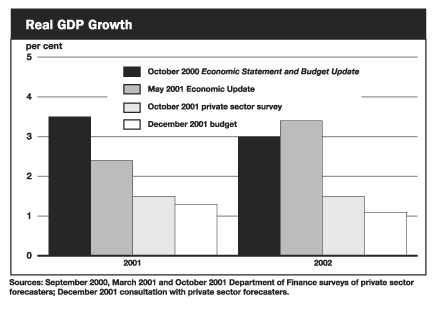
- The Department of Finance conducted its regular survey of Canadian private sector economists in early October, which is the basis for the five-year status quo fiscal projections provided in Chapter 4. Since the October survey new data showed larger than expected GDP contractions in the third quarter of 0.8 per cent in Canada and 1.1 per cent in the United States. In light of these data, the Department of Finance again consulted private sector economists in early December to obtain an update of their October view. This updated outlook is used in this budget for two-year fiscal-planning projections provided in Chapter 7 (see Table 2.2).
- Private sector forecasters expect real GDP to decline further in the fourth quarter, implying growth of 1.3 per cent in 2001 and 1.1 per cent in 2002, a substantial downward revision from October 2000. As in the U.S., they expect positive but modest growth in the first half of 2002, with a solid rebound in the second half of the year. This reflects the impact of lower interest rates, fiscal stimulus from federal and provincial tax cuts, and the expected recovery of the U.S. economy. Growth for 2003 is expected to be a robust 3.9 per cent.
- The adjusted forecast also indicates GDP inflation of 1.3 per cent in 2001 and 0.2 per cent in 2002. Together with changes to forecast real GDP growth, these changes result in expected nominal GDP growth of 2.6 per cent in 2001 and 1.3 per cent in 2002.
- Reflecting a weaker economy and substantial interest rate reductions this year, private sector forecasters expect short-term interest rates of 2.4 per cent in 2002 and 4.0 per cent in 2003. Current private sector expectations for 10-year government bonds are at 5.5 per cent in 2002 and 5.9 per cent in 2003.
Table 2.2
Evolution of the Average Private Sector Forecasts for Canada
|
|
|||
|---|---|---|---|
|
2001 |
2002 |
2003 |
|
|
|
|||
|
(per cent) |
|||
|
Real GDP growth |
|||
|
October 2000 Economic Statement and Budget Update |
3.5 |
3.0 |
3.0 |
|
May 2001 Economic Update |
2.4 |
3.4 |
3.4 |
|
October 2001 private sector survey |
1.5 |
1.5 |
3.9 |
|
December 2001 budget |
1.3 |
1.1 |
3.9 |
|
GDP inflation |
|||
|
October 2000 Economic Statement and Budget Update |
2.0 |
1.5 |
1.9 |
|
May 2001 Economic Update |
1.8 |
1.7 |
2.0 |
|
October 2001 private sector survey |
2.6 |
1.6 |
1.9 |
|
December 2001 budget |
1.3 |
0.2 |
1.9 |
|
Nominal GDP growth |
|||
|
October 2000 Economic Statement and Budget Update |
5.5 |
4.6 |
5.0 |
|
May 2001 Economic Update |
4.2 |
5.1 |
5.4 |
|
October 2001 private sector survey |
4.1 |
3.1 |
5.9 |
|
December 2001 budget |
2.6 |
1.3 |
5.9 |
|
3-month Treasury bill rate |
|||
|
October 2000 Economic Statement and Budget Update |
5.8 |
5.5 |
5.4 |
|
May 2001 Economic Update |
4.6 |
4.7 |
5.4 |
|
October 2001 private sector survey |
4.0 |
3.2 |
4.7 |
|
December 2001 budget |
3.8 |
2.4 |
4.0 |
|
10-year government bond yield |
|||
|
October 2000 Economic Statement and Budget Update |
5.9 |
5.8 |
5.9 |
|
May 2001 Economic Update |
5.3 |
5.6 |
5.8 |
|
October 2001 private sector survey |
5.5 |
5.5 |
5.9 |
|
December 2001 budget |
5.5 |
5.5 |
5.9 |
|
|
|||
| Sources: September 2000, March 2001 and October 2001 Department of Finance surveys of private sector forecasters; December 2001 consultation with private sector forecasters. | |||
The Canadian economy is better positioned to weather the current global slowdown than it has been in decades
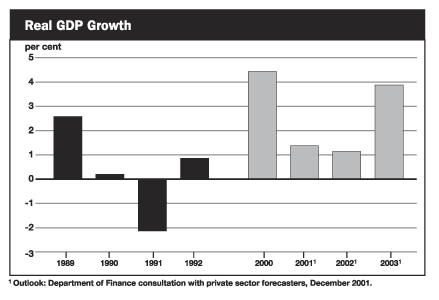
- Canada is not immune to the current global economic slowdown, in particular the slowdown of the U.S. economy. However, Canada is better positioned to cope with negative external economic conditions than was the case in the previous downturn of the early 1990s.
- At that time economic growth declined significantly and remained weak for an extended period. This reflected several factors, including high and rising government deficits, entrenched expectations of high inflation, which kept interest rates high, and rising levels of foreign indebtedness.
- Today this situation has improved markedly, which is reflected in the expectation by private sector forecasters of only a modest slowdown in growth. This expectation represents an acknowledgement of the following differences from the early 1990s:
- a return to fiscal balance has allowed the largest reduction of taxes in Canadian history;
- a solid track record of successfully lowering inflation has eliminated the fear of a return to a high inflation environment;
- there have been large interest rate cuts; and
- Canada’s current account balance and net foreign debt positions have improved significantly.
The fiscal positions of the federal and provincial-territorial governments have improved significantly
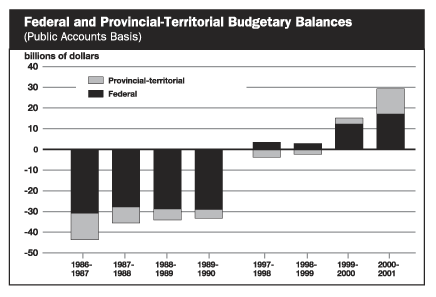
- The most important difference between the current economic situation and that of the early 1990s is the dramatic turnaround in government finances in recent years.
- Prior to the slowdown of the early 1990s, governments ran substantial deficits. This placed constraints on the ability of fiscal and monetary policy to offset economic weakness. High government debt also left the Canadian economy far more vulnerable to external shocks.
- In fact, in the four years leading up to the recession of the early 1990s, the total federal-provincial-territorial government deficit was over $30 billion. In 2000-01 the federal and provincial-territorial governments recorded an aggregate budgetary surplus reaching almost $30 billion.
- As a result, governments are now in a position to play an effective role in stabilizing the economy without a return to the vicious circle of deficits and higher interest rates.
This has provided room for timely supportive fiscal measures
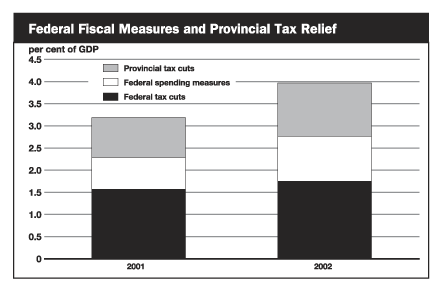
- The improvement in the federal government’s fiscal position has allowed it to introduce the largest tax reduction package in Canadian history, which is providing a substantial, and timely, boost to domestic demand.
- Indeed, reductions in federal taxes amount to over $17 billion in 2001, representing 1.6 per cent of GDP, rising to almost $20 billion in 2002, or 1.8 per cent of GDP. This represents a much larger share of GDP than U.S. federal tax cuts announced last spring – 0.4 per cent in 2001 and 0.7 per cent in 2002.
- In addition, the stimulative impact of new spending measures at the federal level undertaken since the 2000 budget, including the initiatives in this budget, total $8.9 billion in 2001 and $11.0 billion in 2002.
- These measures, combined with federal tax cuts, represent 2.4 per cent of GDP in 2001 and 2.8 per cent in 2002.
- When provincial tax cuts are added, the total amount of supportive fiscal measures is 3.3 per cent of GDP this year and 4.0 per cent in 2002.
Improved fiscal conditions and low inflation have improved monetary policy flexibility
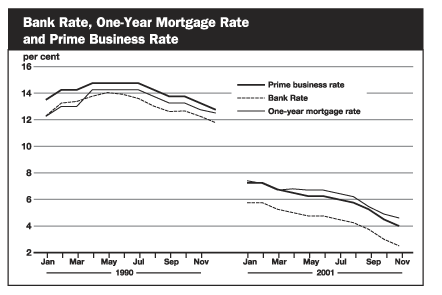
- The elimination of government deficits, along with a 10-year record of setting and meeting low inflation targets, has meant that monetary policy has been able to react to the current weakening economic conditions, a marked departure from the situation existing prior to the recession of the early 1990s.
- In early 1990, as signs of weakness began to appear in the Canadian economy, the combination of high inflation expectations and high fiscal deficits created conditions which prevented easier monetary policy. Indeed, interest rates continued to rise, further dampening economic growth.
- In contrast, the current environment of low inflation and fiscal surpluses has allowed the Bank of Canada to lower interest rates nine times since the beginning of January, for a total of 350 basis points. Short-term interest rates are at their lowest level in more than 40 years.
Lower interest rates are translating into significant reductions in debt-servicing costs for households and businesses
Table 2.3
Savings on Interest Payments Since December 2000
|
|
||
|
One-year mortgage rate |
Prime business rate |
|
|---|---|---|
|
Rate – December 2000 |
7.70 |
7.50 |
|
Rate – December 3, 2001 |
4.60 |
4.00 |
|
Change in rate |
-3.10 |
-3.50 |
|
Monthly payment – December 2000 |
$744.16 |
$1,562.50 |
|
Monthly payment – December 3, 2001 |
$559.05 |
$833.33 |
|
Change in monthly payment |
-$185.11 |
-$729.16 |
|
Change in annual payment |
-$2,221.32 |
-$8,750.00 |
|
|
||
- Lower interest rates will help support domestic demand by sharply lowering the cost of borrowing for households and businesses.
- For instance, declines in mortgage rates since the beginning of this year have meant that a household that renegotiates a one-year mortgage of $100,000 will save more than $2,200 in annual payments compared to the end of last year.
- Similarly, declines in interest rates for businesses mean that annual payments on a small business loan of $250,000 tied to the prime rate would be $8,750 lower than they were at the end of last year.
Canada’s current account and international investment positions are in their strongest positions in decades
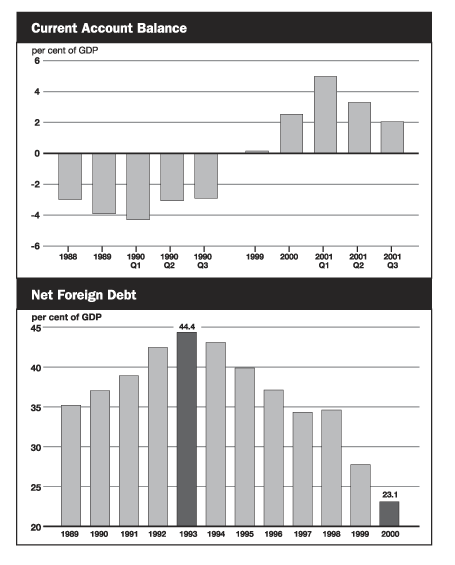
- The turnaround in government fiscal positions has gone hand-in-hand with a significant improvement in Canada’s current account balance.
- Since the first quarter of 2000 the current account balance has averaged 2.9 per cent of GDP – its highest level for any comparable period on record. In comparison, the current account was in a significant deficit position prior to the 1990 recession.
- The elimination of the current account deficit has pushed Canada’s net foreign debt as a share of GDP down to its lowest level since the 1950s. Canada’s net debt to foreigners stood at 23.1 per cent in 2000, a dramatic improvement from levels seen in the late 1980s and early 1990s.
- Table of Contents - Previous - Next -
| Last Updated: 2001-12-10 | |||||